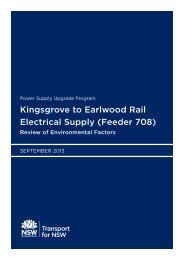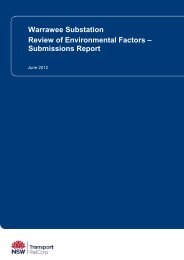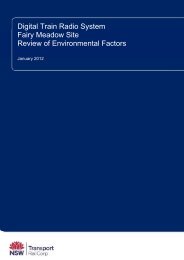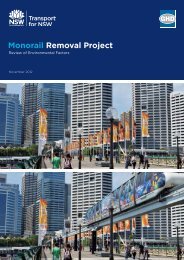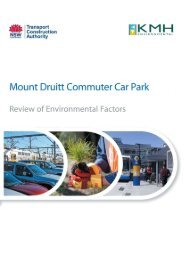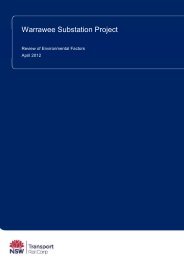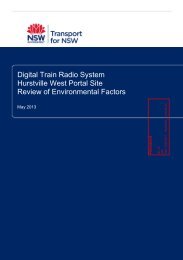Fairfield Transport Interchange Upgrade - Transport for NSW
Fairfield Transport Interchange Upgrade - Transport for NSW
Fairfield Transport Interchange Upgrade - Transport for NSW
Create successful ePaper yourself
Turn your PDF publications into a flip-book with our unique Google optimized e-Paper software.
<strong>Fairfield</strong> <strong>Transport</strong> <strong>Interchange</strong><br />
Determination Report<br />
3.2 Consideration and Response to Submissions<br />
Issue<br />
No.<br />
Submission<br />
No.<br />
Issues raised<br />
Traffic and site access:<br />
1. 1 FAIR 1 Concern raised that zebra crossing will cause traffic to bank<br />
up and down The Crescent to Court Road and Alan Street<br />
which will have a knock on effect on buses entering the bus<br />
interchange. Consider a signalised crossing.<br />
2. FAIR 3 Cars picking up passengers from the train station cause<br />
vehicles to back up along The Crescent all the way down to<br />
the roundabout. Cars can be stuck in traffic <strong>for</strong> 5 to 10<br />
minutes.<br />
<strong>Transport</strong> <strong>for</strong> <strong>NSW</strong> response<br />
The <strong>Fairfield</strong> <strong>Transport</strong> <strong>Interchange</strong> Review of Environmental Factors<br />
(the REF) notes that while there would be queuing from the zebra<br />
crossing particularly in the PM peak, the level of service (LoS) remains<br />
within acceptable levels. This is because the LoS is calculated as a<br />
function of ‘average’ delay <strong>for</strong> all vehicles over an hour. The queuing is<br />
sporadic in nature, building up quickly and dissipating quickly rather<br />
than constant queuing throughout the peak. This is a function of how a<br />
zebra crossing affects traffic flows. For large periods during the peak<br />
there are little or no delays <strong>for</strong> vehicles passing through the zebra<br />
crossing. However when vehicles are required to stop, to let<br />
pedestrians cross the road, queuing can build up quickly, particularly if<br />
the signals at the upstream intersection at Smart Street have turned<br />
green. So the delay can be high <strong>for</strong> some vehicles (hence queuing)<br />
however when averaged out over an hour, the delay would be low.<br />
Roads and Maritime Services review of the traffic impacts determined<br />
that the proposed pedestrian crossing in conjunction with the traffic<br />
signals at the intersection of The Crescent and Smart Street would<br />
work satisfactorily and the delays predicted to occur in the future are<br />
tolerable and can be sustained by the local network. <strong>Transport</strong> <strong>for</strong><br />
<strong>NSW</strong> has committed to further monitoring of the intersections in the<br />
first 3 months of operation of the upgraded interchange to ensure<br />
queuing impacts remain at a manageable level. Refer to Section 6.1.2<br />
in the REF (Volume 1) and Condition of Approval 37 of this<br />
Determination Report.<br />
A <strong>for</strong>malised Kiss and Ride zone will be implemented to allow <strong>for</strong><br />
motorists to pull in off the traffic lane on The Crescent in front of the<br />
station entrance so as to minimise impacts to the westbound traffic<br />
flow on The Crescent. Refer to figure 3.5. in the REF (Volume 1).<br />
As mentioned above in Issue No. 1. <strong>Transport</strong> <strong>for</strong> <strong>NSW</strong> has committed<br />
to undertake further monitoring of The Crescent/Smart Street and The<br />
Ref No: 1452311 7



